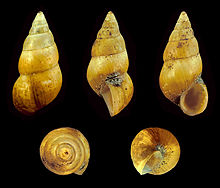Hydrobiidae
| Hydrobiidae | |
|---|---|
 |
|
| Peringia ulvae | |
| Scientific classification | |
| Kingdom: | Animalia |
| Phylum: | Mollusca |
| Class: | Gastropoda |
| (unranked): |
clade Caenogastropoda clade Hypsogastropoda |
| Superfamily: | Truncatelloidea |
| Family: |
Hydrobiidae Stimpson, 1865 |
| Subfamilies | |
|
See text |
|
| Diversity | |
| About 1250 freshwater species and some marine | |
clade Hypsogastropoda
clade Littorinimorpha
See text
Hydrobiidae, common name mud snails, is a large cosmopolitan taxonomic family of very small freshwater snails and brackish water snails that have an operculum, aquatic gastropod mollusks in the clade Littorinimorpha.
There are over 260 species of Hydrobiidae living in Australia.
These are very small or minute snails, with a shell height of less than 8 mm. The dextrally-coiled shells are smooth (except for growth lines conforming to the shape of the outer lip) and are usually rather nondescript. The shell offers very few robust characteristics to the systematist who is attempting to classify the species within this family. This difficulty is compounded by a high degree of intraspecific variation. Descriptions often have to be based on the characteristics of the operculum, radula and penis.
The shell of species within this family varies from planispiral to needle-shaped. The shell may have an open umbilicus or a plugged umbilicus. The thickness of the shell can vary from thin to fairly solid. The shell may be transparent and horn-colored, or colorless.
The number of whorls in the shell varies between two and eight. The shell can sometimes even assume a corkscrew or hornlike shape by loosening of the attachment of body whorl. The periostracum (outer layer of the shell) is usually thin, and is often colored. It can sometimes show hair-like projections.
...
Wikipedia
